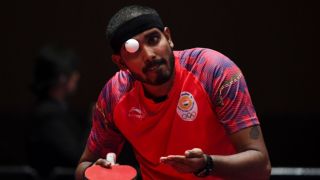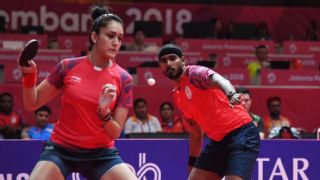|
Achanta Sharath Kamal's famed bright, bold bandana with the warrior-style knot is now replaced by a sobered-down headband. The bang-heavy coif has given way to a semi-bald look. He's nearly indistinguishable without his two primary style markers. It may well be, he jokes, the lucky charm that India was missing. This is the first time the country has ever won a medal in table tennis since it was introduced in the Asian Games in 1958. And he doesn't wish to risk even the slightest change. In this edition, India has already won a bronze medal each in the men's team event and mixed doubles. Earlier, at the Commonwealth Games in April this year, both the men and women for the first time topped their categories and Indian table tennis players returned with their richest haul - eight medals - in the history of the competition. A month later, the men's team's finished 13th at the World Championship, their best-ever showing in over three decades. It also ensured that they automatically qualified for the Championship division (first of three divisions) for the 2020 edition. A three-time Olympian now in his fourth Asian Games, Sharath at 35, is something of an elder statesman in the national side. What he sees now unfolding before him, a renaissance, a new order as it were in the sport, with the kind of panoramic view that comes with also being a part of it, is in fact unique. "You know this day was set in motion two years ago at the Rio Olympics," he tells ESPN, "For the first time, we had four players qualifying for the Games then," he adds, with wizened perspective, "Also, the active funding players began to receive from TTFI and SAI and the eco-system that it built around us after Rio has been crucial."  The results were for all to see in a year. By the beginning of 2017, six Indian men's players and three women's players had broken into the top-100. "The funding ensured we didn't have to worry about making it to tournaments, training or exposure trips. For players, the monetary freedom to pick our calendars - so we know whom we are playing where and when - is a massive relief. Over the last one year we have been taking turns to beat the top players on the pro tour. It was a sure sign of things to come." At the team event in Jakarta, having qualified for the quarterfinals after beating Vietnam 3-0, India was to next face either one of the group toppers (China, Korea and Japan). Before the knock-out draw, the team huddle was one of hope and anxiety. The only opponent they had a half-decent chance against was Japan. Of the total 98 gold medals won so far in the sport since its inception at the Asian Games, China, Japan and Korea together account for 91 of them. China, of course, takes the lion share with 61 medals. "We'd lost to them (Japan) narrowly at the Asian Championships last year and knew it would be at least slightly better than playing China or Korea against whom our chances would've been slim. We had also lost in the previous two editions to China in the quarterfinals. Thankfully, we got lucky in the draw this time."  Sharath, currently the highest-ranked Indian at world No. 33, then came up with a masterstroke. Re-jigging the playing order and slotting himself in the second match instead of the opening encounter, where he's usually positioned in team events, set up their chances well. "I had beaten their No. 1 player Kenta (Matsudaira) twice before, so I pitched myself against him for the second match and pushed Sathiyan up to play the first. Once Sathiyan won that match, it gave us a head-start and after my result, the lead only widened. Much like we'd planned, we got an early advantage instead of leaving it late to a decider." His mixed doubles run with Batra also ended in a bronze. This, after they were wrung dry from playing four matches in a single day. "Both the pre-quarterfinals and quarters were close and went into tie-breakers. By the semifinals, we just wanted to finish and go home. But if we continue playing the way we are now, we stand a decent medal prospect in the mixed event at the 2020 Olympics." He holds up the contrasting scenarios from his first Asian Games appearance in Doha 2006 to now his fourth as a testimony of the sport's journey. Then, India had lost 1-3 to Japan. Now they have a win by an identical margin and two medals that they couldn't have imagined back then. "Even four years ago, none of the other teams would have seen this coming. We have made fantastic progress and the Commonwealth Games medals gave us a sort of confidence we never had before. Today, other teams look at us with some fear and a fair bit of preparation. Earlier, the Chinese wouldn't bother to look us up, they'd just show up for the matches and then on the table figure out how to beat us, which they did pretty well. Now, they do a video analysis before playing us. It just shows how seriously we're taken even by the world beaters.  For Sharath, the spate of great results also brings with it the prospect of disquiet on the domestic front. "When we didn't have the wins and the medals, it was easier to decide when to quit, now it's like so when do I stop at all? I'm doing well now and I think I can push till at least 2020. Of course it would need a fair bit of convincing since my wife and seven-year old daughter wonder all the time why I can't play while staying at home in Chennai ." He also has to make up for missing his son's first birthday a week ago. The new hair-do offering a constant, visible reminder. "My son had to get his head tonsured for the ceremony, so I thought of shaving mine too." And with so much going right, Sharath doesn't wish to venture a chance. "Now that we've made history, I might just keep this look."
|
